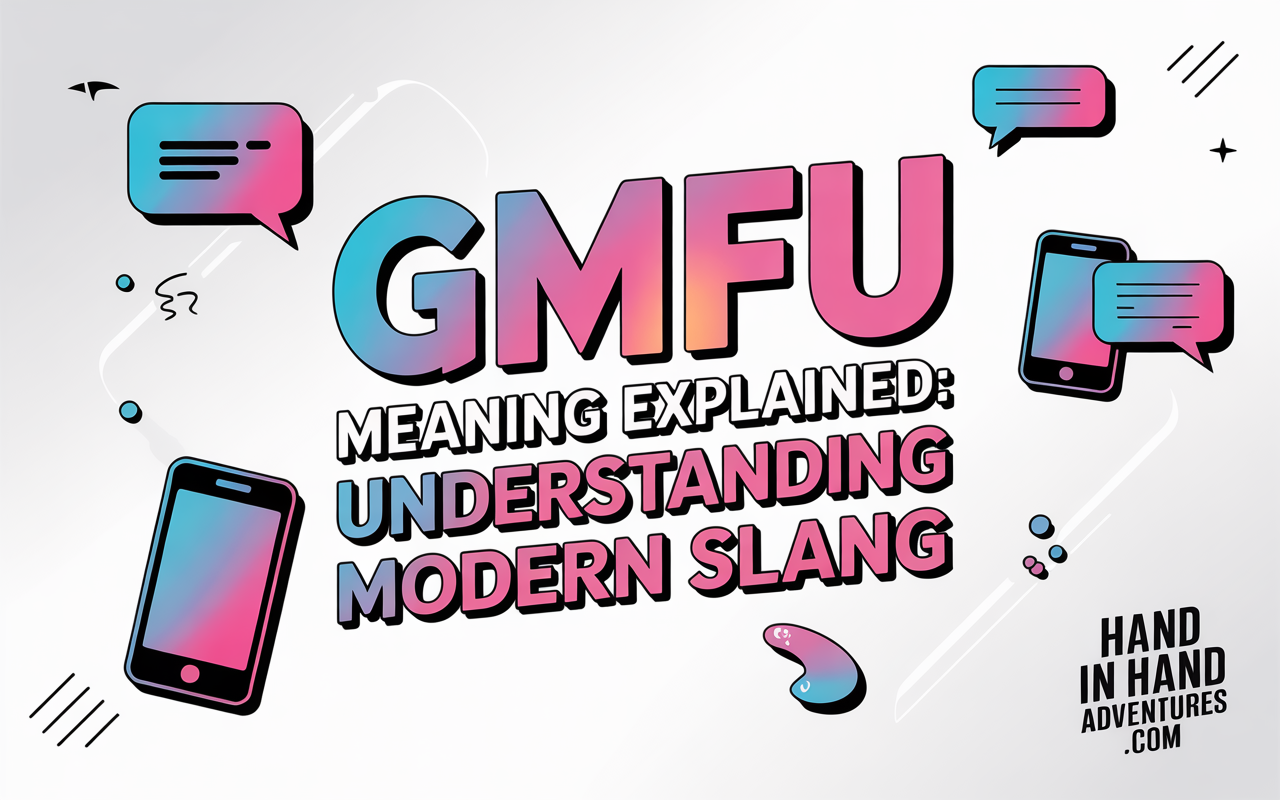GMFU, a modern digital slang term, stands as a powerful symbol of emotional reaction and cultural evolution in online communication. The acronym, which expands to “Got Me F***ed Up,” conveys feelings of shock, frustration, disbelief, or betrayal. It’s widely used on social media platforms like Twitter, TikTok, Instagram, and Snapchat, where brevity and expression dominate. Because emotions in online communication are often hard to read, GMFU bridges that gap—letting users instantly show intense feelings. In this article, the history, interpretation, and nuances of GMFU will be explored thoroughly, revealing why it resonates so strongly with younger generations.
Origin and cultural evolution of GMFU
The roots of GMFU can be traced back to African American Vernacular English (AAVE) and the early internet’s informal expression spaces. Originally, the phrase “You got me f***ed up” appeared in hip-hop lyrics and street slang during the 1990s. As online communities expanded, users shortened it to GMFU, mirroring the linguistic shift from full phrases to acronyms. Over time, GMFU became mainstream through meme culture, viral videos, and captions. Its tone evolved—from raw anger to humorous disbelief. This transformation highlights how slang morphs to fit context, tone, and platform. While once edgy, GMFU now embodies a flexible emotional shorthand used by millions across digital spaces.
What GMFU stands for and how it’s interpreted
At its simplest, GMFU translates to “Got Me F***ed Up.” However, context determines its tone—sometimes angry, sometimes humorous. For instance, if someone posts “He said pineapple belongs on pizza—GMFU,” the reaction is playful disbelief. But in another situation, like “You lied about everything—GMFU,” it expresses betrayal and emotional pain. Therefore, GMFU functions as a multi-dimensional emotional code. It doesn’t just express one emotion; it amplifies an entire mood. Context, emojis, and platform cues influence how readers interpret it. Thus, understanding GMFU requires reading between the lines, not just the words.
Popularization through social media
The explosion of social platforms transformed GMFU from niche slang into a universal digital reaction. Twitter users adopted it for comedic posts, while TikTok creators added GMFU to captions for relatable content. Instagram and Snapchat users, craving expressiveness within character limits, embraced the term as a reaction to absurd or frustrating moments. The rise of meme culture, with its focus on irony and exaggeration, cemented GMFU’s popularity. In every form—comments, tweets, or memes—GMFU embodies an instant emotional exclamation, reducing complex reactions into concise digital shorthand.
Common situations where GMFU appears
GMFU appears when users face shocking, ridiculous, or unfair scenarios. Examples include:
-
A person discovering a hidden charge on an online order and tweeting “GMFU.”
-
Someone watching a TV twist they didn’t expect: “That ending GMFU!”
-
A caption under a broken product photo: “Used it once—GMFU.”
Because digital expression rewards exaggeration and brevity, GMFU fits naturally into everyday frustration, humor, or disbelief. It captures reactions that are too big for polite phrasing but too casual for full sentences.
Emotional power of GMFU
Unlike traditional slang, GMFU packs layered emotional weight. It expresses both vulnerability and defiance. The phrase says, “You’ve wronged me” or “This situation messed me up.” This emotional honesty appeals to audiences tired of filtered perfection online. In fact, GMFU’s power lies in its authenticity—it doesn’t sugarcoat. Instead, it humanizes online communication, revealing frustration, surprise, and raw reaction. While many internet phrases fade, GMFU persists because it satisfies an enduring emotional need: to feel seen, understood, and expressive.
Humor and irony in GMFU usage
Despite its intense origin, GMFU often carries humor. Internet users have redefined it into ironic commentary. For example, someone might post a photo of a cat wearing sunglasses with the caption, “This filter GMFU 😂.” The exaggerated tone turns seriousness into comedic relief. Humor transforms GMFU into an inside joke—an emotional exaggeration shared by millions. This playful tone demonstrates how internet culture recycles expressions, blending irony and sincerity into something uniquely digital.
Differences between GMFU and similar slang
While GMFU resembles other reaction slang, its tone differs. For example:
| Slang | Meaning | Tone Difference |
|---|---|---|
| WTF | What the F*** | More confusion, less personal emotion. |
| SMH | Shaking My Head | Softer disapproval, less emotional depth. |
| LMAO | Laughing My A** Off | Pure humor, lacking frustration. |
| GMFU uniquely blends humor with irritation. It’s personal yet public, casual yet charged. Unlike WTF, GMFU often implies a personal stake: the speaker feels affected or wronged. This nuance makes GMFU more relatable in emotional storytelling. |
Why GMFU resonates with Gen Z and Millennials
Younger generations value expression that feels authentic and unfiltered. GMFU satisfies this by combining honesty with wit. Because Gen Z thrives in meme culture, where exaggeration is humor currency, GMFU fits perfectly. It’s both dramatic and concise. Moreover, Millennials, who grew up through the shift from early internet slang to modern memes, find GMFU nostalgic yet fresh. The phrase bridges generational online language, allowing both groups to express emotional states vividly.
GMFU in memes and viral trends
Memes gave GMFU new life. Screenshots of wild text exchanges, unexpected plot twists, or viral fails often feature GMFU as a caption. For example, a meme showing an overcooked pizza might read, “Thought I was a chef… GMFU.” The combination of image and slang amplifies humor. Memes depend on shared emotional understanding—GMFU delivers that instantly. Its adaptability makes it a meme caption favorite across TikTok, Reddit, and Instagram.
Linguistic role of GMFU in online language
From a linguistic standpoint, GMFU reflects how English evolves under digital pressure. Acronyms like LOL, BRB, and SMH simplified communication, but GMFU adds emotional specificity. Linguists note that slang such as GMFU demonstrates language democratization—meaning evolves from community use, not top-down authority. As people remix words for identity and humor, GMFU’s existence showcases how online communities create culture in real time.
Regional and cultural nuances in GMFU usage
Though globally used, GMFU still carries cultural weight. In African American communities, its original tone may express genuine frustration or disrespect. In broader internet use, it’s often softened into humor. Understanding these distinctions is vital to using GMFU respectfully. Context determines whether it’s seen as funny, intense, or inappropriate. As slang spreads globally, sensitivity to origin and tone preserves its meaning and authenticity.
When not to use GMFU
Because GMFU contains implied profanity, it’s best avoided in professional or formal settings. Using it in work emails, school discussions, or public statements may appear disrespectful. Also, in emotionally serious contexts—such as discussing trauma or loss—GMFU might trivialize the issue. The best practice is to reserve GMFU for informal, peer-level communication, where tone and humor are clear.
Misinterpretations of GMFU
Misunderstandings occur when readers take GMFU literally. Without tone indicators like emojis or context, someone might interpret it as anger instead of humor. Therefore, many users add emojis (“😭,” “😂”) or punctuation (“GMFU!!”) to guide interpretation. Misuse can also arise from generational gaps—older audiences unfamiliar with slang may view GMFU as aggressive. Thus, awareness of audience remains key.
GMFU in music and pop culture
The phrase “Got Me F***ed Up” has long appeared in hip-hop and R&B lyrics, reinforcing its connection to raw emotion. Songs by artists such as Bryson Tiller (“Don’t”), Bebe Rexha, and Kehlani have incorporated similar expressions. As the acronym GM-FU entered digital lexicon, its appearance in captions and lyrics blurred the boundary between slang and art. Pop culture therefore sustains GMFU’s popularity—each viral lyric or meme keeps it alive in everyday talk.
The psychology behind GMFU
Psychologically, GM-FU operates as emotional catharsis. Typing it allows users to release frustration without elaborating. This immediate release feels validating in fast-paced online exchanges. Moreover, because language shapes emotion, GM-FU helps label otherwise wordless feelings. In essence, it empowers users to own their emotions while connecting through shared experience.
The role of GMFU in identity and belonging
Using GM-FU signals digital literacy and belonging. In online communities, slang functions as an identity badge. Knowing GM-FU—and when to use it—marks membership in the modern internet culture. It signals humor, adaptability, and cultural awareness. For marginalized groups, using phrases rooted in AAVE may also express solidarity or cultural authenticity. However, non-native users must apply sensitivity and respect toward its origins.
GMFU in textual communication vs. spoken language
In spoken form, people often use the full phrase “You got me f***ed up!” for emphasis, while GM-FU dominates text. Speech carries tone and inflection, making the phrase emotional and confrontational. Online, GM-FU condenses that emotion into letters, relying on context for tone. Emojis, gifs, and punctuation enhance expressiveness—turning text into emotional theater.
Risks of overusing GMFU
Overuse diminishes GMFU’s emotional intensity. If every mild inconvenience is “GM-FU,” the phrase loses its impact. Strategic use maintains its expressiveness. Linguistic fatigue happens when powerful terms become filler, and GM-FU risks that fate if abused. Therefore, use it sparingly for moments that truly evoke shock or disbelief.
GMFU’s relationship with emotional authenticity
The appeal of GM-FU lies in its unapologetic honesty. Online personas often project perfection; GM-FU breaks that façade. Saying “GM-FU” is like admitting vulnerability and irritation simultaneously. It allows users to be authentic in spaces dominated by curated images and filters. In that sense, GM-FU symbolizes rebellion against performative positivity.
How marketers and creators leverage GMFU
Brands aiming to appear relatable sometimes adopt internet slang, including GM-FU. However, forced usage can backfire. Authenticity matters; if a brand voice doesn’t match the slang’s tone, it may feel disingenuous. Successful examples include meme-based campaigns where GM-FU appears in user-generated content rather than official posts. Marketers benefit more from understanding GMFU than from overusing it.
Future of GMFU and online slang
Like all slang, GM-FU will evolve. Its intensity may fade as newer acronyms emerge. Already, derivatives such as “YGMFU” (You Got Me F***ed Up) appear occasionally. As internet culture renews itself every few years, some phrases vanish while others become immortalized in memes. GMFU’s blend of emotion and brevity suggests it may endure longer than most slang, at least until digital expression changes again.
How to decode GMFU if you’re new to slang
For newcomers, understanding GM-FU starts with context clues. Look for emotional indicators in accompanying text or visuals. If laughter or surprise surrounds it, it’s likely humorous. If frustration dominates, it’s serious. Online dictionaries like Urban Dictionary offer definitions, but lived context offers the clearest interpretation. Observing usage across platforms helps decode not just GM-FU but internet language in general.
Impact of GMFU on digital communication
GMFU’s popularity reshapes how emotion is conveyed online. Instead of long explanations, people use a few letters to express complexity. This evolution mirrors a larger linguistic shift: written communication now rivals speech in emotional nuance. Acronyms like GM-FU make digital spaces more expressive, bridging the gap between words and feelings.
Conclusion
Ultimately, GMFU captures the essence of modern online communication—fast, expressive, and emotionally layered. From its AAVE roots to its viral meme status, GM-FU exemplifies how language adapts to cultural and technological change. It lets users communicate intensity without verbosity, frustration without aggression, humor without dilution. Used wisely, GM-FU enriches digital dialogue and connects people through shared emotional shorthand. Though slang will keep evolving, GM-FU remains a testament to how four letters can encapsulate the chaos, humor, and heart of internet culture.

